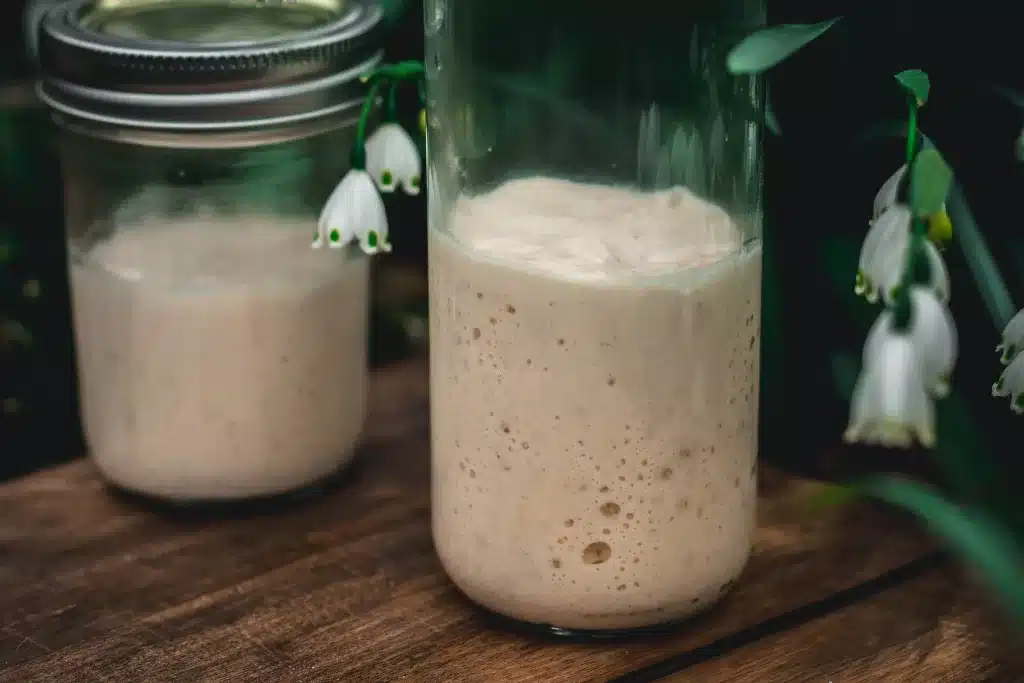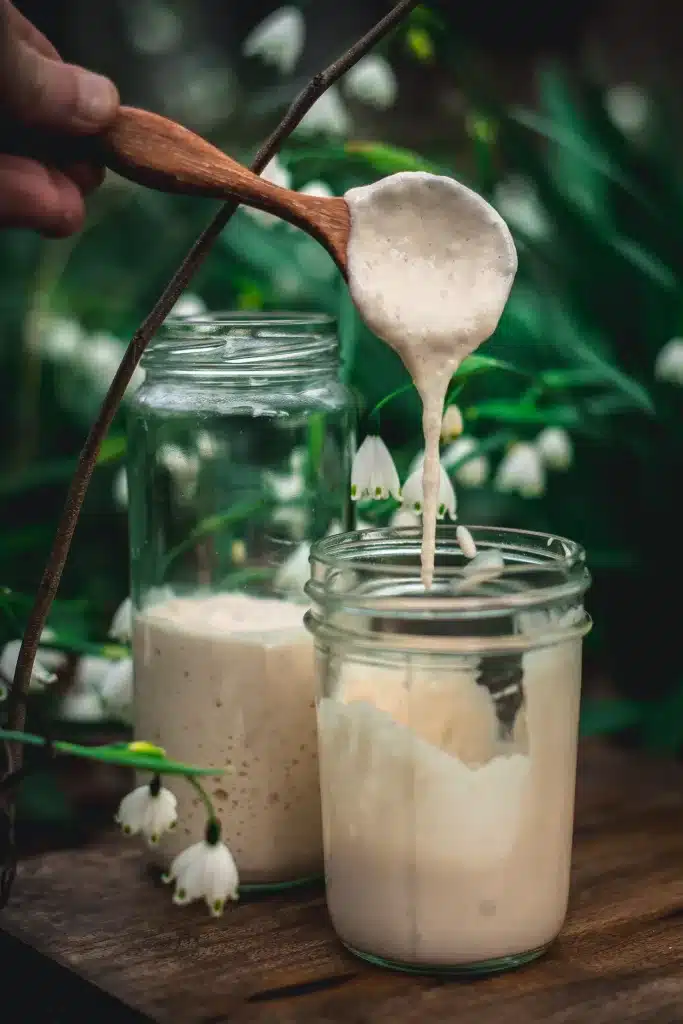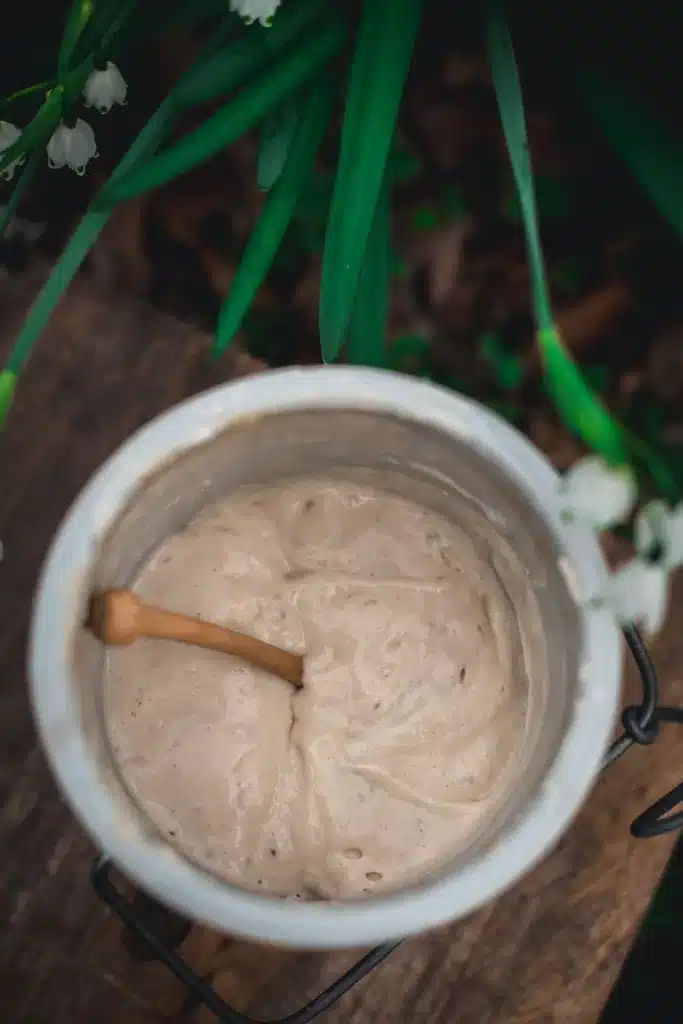
After getting married this past summer, I didn’t feel as though I had officially moved in with my husband until I brought over my sourdough starter. This little crock of flour and water can quickly make a house feel like a home as it displays the work of attentive hands. It exemplifies patience, planning, dedication, and service. And yes, it can also be simple, but it does require some knowledge and foresight. As this blog continues to grow, I receive more and more comments about feeding sourdough starter. In addition to waxing poetic about attentive hands and patience, I wanted to write this guide as a response to these comments, as well as sharing my updated feeding schedule.
“There is not a thing that is more positive than bread.” – Fyodor Dostoevsky
Feeding sourdough starter: how much?
Whenever I bake, I try to use most of the starter and leave only a few tablespoons in my starter crock or jar. I do this because I don’t like to waste the starter by throwing it away and the starter responds well to large feedings. When I want to bake in the next day or two, I will add around a cup of water and a cup of flour to those 2-3 tablespoons of starter and allow it to rise on the counter for about half a day or over night. This large ratio of flour and water to starter gives it lots of food to eat and results in a fast and bubbly rise. Remember when you are feeding sourdough starter: it’s not an exact science and you don’t need to measure and weigh every time. The art of feeding sourdough starter is more about learning the signs of an active starter and knowing the steps to achieve that rather than an exact formula.
The art of feeding a sourdough starter is more about learning the signs of an active starter and knowing the steps to achieve that rather than an exact formula.
How often do you feed?
If you are baking several times a week or for a large family, you may need to feed your starter almost every day. For the rest of us, feeding a day or so before you are ready to mix your dough is best. I like to keep my starter in the fridge when I am not using it and then take it out to feed the night before (or the morning of) I’m ready to bake.
What to feed?
I feed my starter mostly organic bread flour. Sometimes I add a little bit of rye for flavor, texture, and rise. I wrote an entire blog on this topic so definitely check it out for more information!
Supplies for Feeding Sourdough Starter
Starter Jar
~Weck jars are excellent for rising starter and much more versatile than jars that are marketed particularly for sourdough starter.
Jar Spatula
~A small jar spatula is ideal for mixing your starter.
Starter Crock
~I like to use a ceramic crock to help regulate the temperature of the starter.
Flour Scoop
~I prefer using a flour scoop rather than a cup measure when baking.
Feeding sourdough starter FAQ:
Why isn’t my starter rising?
Temperature might be affecting your starter so make sure it’s in a warm place. You also might not be feeding your starter enough flour and water. My best advice is to discard everything but a few tablespoons of starter and give it a large feeding. You can also read my blog on the Four Reasons Your Sourdough Starter isn’t Rising for more information.
Can I feed my starter directly out of the fridge?
If your starter is very active and mature, it can be fed directly from the fridge. I sometimes do this in a pinch and haven’t had any issues but I wouldn’t recommend it for everyone. If your starter isn’t as active or mature, or you are new to sourdough, wait for it to come to room temperature before feeding it.
Can my starter rise in the fridge?
Cold temperatures slow fermentation, so I would not recommend letting your starter rise in the fridge.
Can I bake with a starter that isn’t active enough?
I would not recommend baking with an inactive starter unless you are very experienced and your starter is very mature.
How do I know when my starter is ready to use?
The two best ways to test if your starter is ready to use:
- The float test: float a little bit of starter in water, if it floats, it’s ready. If it does not float, wait for it to finish rising or feed it again.
- This next test involves the consistency of the starter. If you look at the top of your starter, it should be full of air bubbles. Take a spoon and gently swipe from the edge of your jar to the center. If your starter shows stringy, but elastic air bubbles and gluten strands, then it is ready. If your starter deflates immediately, looks runny, or doesn’t hold shape, it is not ready.
What should the consistency of my starter be?
There is no “correct” consistency for sourdough starter. When feeding sourdough starter, I like mine to be about as thick as muffin batter, but you’ll need to experiment to see what consistency works best for you!
When should I put my starter in the fridge?
I keep my starter in the fridge whenever I am not using it because the cold slows the fermentation process which means I don’t need to feed the starter as often. Please read my example weekly schedule below to see more precisely what this looks like.


Sourdough weekly schedule example:
Below is an example of my weekly sourdough schedule for further inspiration:
Monday
Place starter in the fridge after weekend baking
Wednesday night
Pull starter from the fridge and allow it to come to room temperature
Thursday morning
Feed starter
Thursday afternoon
Mix dough with active starter
Thursday Night
Place starter in fridge
Saturday Night
Pull starter from the fridge and allow it to come to room temperature
Sunday Morning
Feed starter
Sunday Afternoon
Mix dough with active starter
Monday
Place starter in the fridge after weekend baking
This was incredibly helpful! Thank you.
After using the active starter to make the dough, do you feed the rest of the starter again before placing back in the fridge? I’ve been doing this but realizing maybe I don’t need to!?
Yes, that is exactly what I do and it works great!
Unless you’re ready to bake again right away, the starter can go back in the fridge until you are ready.
xo,
Regina